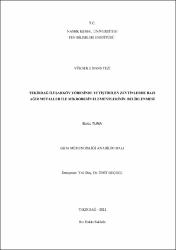| dc.contributor.author | Tuna, Burcu | |
| dc.date.accessioned | 2017-05-09T13:03:04Z | |
| dc.date.available | 2017-05-09T13:03:04Z | |
| dc.date.issued | 2011 | |
| dc.identifier.uri | https://hdl.handle.net/20.500.11776/875 | |
| dc.description.abstract | Ağır metaller doğada son derece kalıcıdır; biyolojik ve ısı yoluyla parçalanamazlar ve bu nedenle kolayca toksik seviyelerde birikebilirler. Sanayi için önemli olan ağır metaller, havaya, toprağa ve suya karıştıklarında, insan ve hayvan sağlığı açısından tehlike oluşturmaktadır. Diğer gıdalarda olduğu gibi zeytinin bileşimi de çevre koşullarından etkilenmektedir. Bu çalışmada; yol, fabrika arazisi, sulama kanalı yakınında yetiştirilen sofralık zeytinlerin ağır metal (Cd, Co, Cr, Cu, Fe, Zn, Ni ve Pb) ve mikro besin (Mn, S, Mg, Ca, P ve K) element konsantrasyonları araştırılmıştır. Buna göre ağır metal ve mikrobesin elementlerinin konsantrasyonları sırasıyla 0.60 ± 0.14-3.85 ± 1.76, 14.51 ± 0.42-64.82 ± 4.23, 2.36 ± 0.91?7.66 ± 2.09, 0.100 ± 0.064?0.415 ± 0.049, 0.245 ± 0.065?0.876 ± 0.081, 3.20 ± 0.82?8.29 ± 0.41, 544.0 ± 136.1?923.6 ± 145.3, 365.6 ± 148.6?789.3 ± 185.3, 780.6 ± 102.8?1245.6 ± 107.8, 901.6 ± 194.0?1617.6 ± 149.8 ve 17953.3 ± 3893.4?34430.0 ± 7818.4 mg/kg Cu, Fe, Zn, Ni, Pb, Mn, S, Mg, Ca, P ve K için bulunmuştur. Zeytin örneklerinde Cd, Co ve Cr`a rastlanmamıştır. Yapılan analiz sonucunda Pb, Cu`ın Codex Alimentarius ve Türk Sofralık Zeytin Standartları'na göre yasal sınırlarda olduğu saptanmıştır. | en_US |
| dc.description.abstract | Heavy metals are extremely persistent in the environment; they are non-biodegradable and non-thermo degradable and thus readily accumulate to toxic levels. When released into open areas, there is a risk that some heavy metals that are important for industry will pass into human and animal bodies. Like that of other foods, olive composition is also influenced by various environmental conditions. The concentration of heavy metals (Cd, Co, Cr, Cu, Fe, Zn, Ni and Pb) and micronutrients (Mn, S, Mg, Ca, P and K) in table olive samples grown in different conditions, such as on a main road, in factory areas and on irrigated land, was investigated. The concentrations of heavy metals and micronutrients in the samples were found to be 0.60 ± 0.14-3.85 ± 1.76, 14.51 ± 0.42-64.82 ± 4.23, 2.36 ± 0.91?7.66 ± 2.09, 0.100 ± 0.064?0.415 ± 0.049, 0.245 ± 0.065?0.876 ± 0.081, 3.20 ± 0.82?8.29 ± 0.41, 544.0 ± 136.1?923.6 ± 145.3, 365.6 ± 148.6?789.3 ± 185.3, 780.6 ± 102.8?1245.6 ± 107.8, 901.6 ± 194.0?1617.6 ± 149.8 and 17953.3 ± 3893.4?34430.0 ± 7818.4 mg/kg for Cu, Fe, Zn, Ni, Pb, Mn, S, Mg, Ca, P and K, respectively. Cd, Co and Cr were not detected in all olive samples. The analytical results obtained for Pb, Cu levels show that they were below the legal limits established by the Codex Alimentariıus and Turkish local table olive standards. | en_US |
| dc.language.iso | tur | en_US |
| dc.publisher | Namık Kemal Üniversitesi | en_US |
| dc.rights | info:eu-repo/semantics/openAccess | en_US |
| dc.subject | Zeytin | en_US |
| dc.subject | ağır metal | en_US |
| dc.subject | şarköy | en_US |
| dc.subject | kirlilik | en_US |
| dc.subject | Olive | en_US |
| dc.subject | heavy metal | en_US |
| dc.subject | pollution | en_US |
| dc.title | Tekirdağ ili Şarköy yöresinde yetiştirilen zeytinlerde bazı ağır metaller ile mikrobesin elementlerinin belirlenmesi | en_US |
| dc.title.alternative | Determination of some heavy metals and micronutrient elements in olives grown in the Sarkoy region | en_US |
| dc.type | masterThesis | en_US |
| dc.department | Enstitüler, Fen Bilimleri Enstitüsü, Gıda Mühendisliği Ana Bilim Dalı | en_US |
| dc.relation.publicationcategory | Tez | en_US |



















